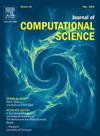Dispersal- and harvesting-induced dynamics of single-species inhabited in minimal ring-shaped patches
IF 3.7
3区 计算机科学
Q2 COMPUTER SCIENCE, INTERDISCIPLINARY APPLICATIONS
引用次数: 0
Abstract
We investigate two discrete-time models of a single-species dispersed between three patches located on a ring. The dynamic models are formulated by identical logistic maps with linear coupling. The co-existing equilibrium completely depends on the intrinsic growth rate and carrying capacity. However, stability depends only on intrinsic growth rate and dispersal rate. We shall analytically present the stability analysis of both the trivial and coexisting equilibrium in a two parameter plane. Our main focus is to explore the bifurcations at the coexisting equilibrium and their consequences in ecology. Increasing dispersal rate leads to a period-doubling bifurcation in the bi-directional dispersal model followed by a Neimark-Sacker bifurcation arising from each periodic branch. Our analysis reports the existence of either three stable 2-cycles or three distinct quasi-periodic modes resulting in either periodic–periodic–periodic multistability or quasiperiodic–quasiperiodic–quasiperiodic multistability. In contrast to the bi-directional model, only a Neimark-Sacker occurs in the uni-directional dispersal model for increasing dispersal rate. This uni-directional dispersal strategy does not exhibit any multistability. The co-existing equilibrium may experience an instability switching in both models while introducing harvesting in one of the patches. Under harvesting, the bi-directional model could induce a Neimark-Sacker bifurcation which is impossible to occur for increasing dispersal. We shall estimate the effort levels to achieve the same amount of harvested yield in both uni- and bi-directional dispersal models. These results might be interesting from biological conservation and fishery management viewpoints.
最小环形斑块中单一物种的扩散和收获诱导动态
我们研究了两个分散在环上三个斑块之间的单一物种的离散时间模型。动态模型由具有线性耦合的相同逻辑映射表示。共存平衡完全取决于内在增长率和承载能力。然而,稳定性仅取决于内在生长速率和扩散速率。我们将解析地给出两参数平面上平凡平衡和共存平衡的稳定性分析。我们的主要重点是探讨共存平衡的分歧及其对生态学的影响。随着扩散速率的增加,在双向扩散模型中出现周期加倍分岔,每个周期分支都出现neimmark - sacker分岔。我们的分析报告了三个稳定的2周期模式或三个不同的准周期模式的存在,从而导致周期-周期-周期多稳定性或准周期-准周期-准周期多稳定性。与双向扩散模型相比,单向扩散模型只出现neimmark - sacker现象,增加了扩散速率。这种单向扩散策略不表现出任何多稳定性。共存平衡可能在两个模型中经历不稳定切换,而在其中一个补丁中引入收获。在收获条件下,双向模型会引起neimmark - sacker分岔,而这种分岔在增加分散时是不可能发生的。我们将估计在单向和双向扩散模型中达到相同收获产量的努力水平。从生物保护和渔业管理的角度来看,这些结果可能是有趣的。
本文章由计算机程序翻译,如有差异,请以英文原文为准。
求助全文
约1分钟内获得全文
求助全文
来源期刊

Journal of Computational Science
COMPUTER SCIENCE, INTERDISCIPLINARY APPLICATIONS-COMPUTER SCIENCE, THEORY & METHODS
CiteScore
5.50
自引率
3.00%
发文量
227
审稿时长
41 days
期刊介绍:
Computational Science is a rapidly growing multi- and interdisciplinary field that uses advanced computing and data analysis to understand and solve complex problems. It has reached a level of predictive capability that now firmly complements the traditional pillars of experimentation and theory.
The recent advances in experimental techniques such as detectors, on-line sensor networks and high-resolution imaging techniques, have opened up new windows into physical and biological processes at many levels of detail. The resulting data explosion allows for detailed data driven modeling and simulation.
This new discipline in science combines computational thinking, modern computational methods, devices and collateral technologies to address problems far beyond the scope of traditional numerical methods.
Computational science typically unifies three distinct elements:
• Modeling, Algorithms and Simulations (e.g. numerical and non-numerical, discrete and continuous);
• Software developed to solve science (e.g., biological, physical, and social), engineering, medicine, and humanities problems;
• Computer and information science that develops and optimizes the advanced system hardware, software, networking, and data management components (e.g. problem solving environments).
 求助内容:
求助内容: 应助结果提醒方式:
应助结果提醒方式:


